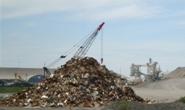Scrap Prices North America

Shredded & Busheling Scrap Settle Close to Par with One Another
Written by John Packard
February 11, 2014
Scrap prices for February deliveries to the domestic mills have settled in most areas of the country. In Chicago and the Upper Midwest we are seeing prices down from the previous month as #1 HMS (heavy melt scrap) is at $390 per gross ton, shredded scrap ranges from $400-$410 per gross ton (average $405) and #1 busheling is almost exactly the same as shredded coming in at $408-$412 per gross ton (average $410). Plate and structural scrap was reported to be $405 per gross ton in the Chicago area.
It is highly unusual for prime grades of scrap such as #1 busheling and bundles to sell at the same level as shredded scrap. Prime grades have lower residuals (metals such as copper which cannot be removed during the steel making process) this makes them more valuable to the domestic mills – especially sheet mills who try to minimize or eliminate residuals from their scrap mix in the furnace.
One of our scrap sources told us regarding the unusual pricing for shred and busheling, “I think we’ve seen busheling and shred trade near one another a few times in the last few years. It’s a temporary phenomenon until any busheling overhang goes away as mills buy more of it relative to shred. The same thing will eventually happen this time too.”
In the Ohio Valley our sources are advising scrap prices are about the same as the Chicago area mills. One mill – V&M – paid $415 for shred but their specifications are tighter on the product which creates a bit of an unusual buying situation. In the Cleveland area some of the mills paid $410, while in Pittsburgh shred prices were closer to $405 per gross ton.
In the East the two major mills – Steelton and Coatsville – paid approximately $380-$385 for both shred and busheling.
One scrap dealer had this to say about price direction from here, “As far as March goes, it’s too difficult to say yet. Flows are still very weak and the continued poor weather is not helping. Absent the lack of export demand we’re experiencing now, this market is probably not down much if at all in February and up in March.
“I think dealers and even the exporters will have trouble filling their orders in February. That doesn’t mean that the mills won’t try to cancel orders in March, but if they do and flows are still weak I would not be surprised to see dealer resistance to lower prices. That may change in April with better flows if export demand doesn’t recover, but we have a ways to go until then.”
This dealer then went on to state, “And eventually we will reach a point where the exporters get back to exporting. That will make things very interesting indeed. Will the exporters continue to sell scrap to the domestic consumers, and if not will flows be tight again to drive prices sharply higher even if it’s temporary? We’ll have to wait and see….”

John Packard
Read more from John PackardLatest in Scrap Prices North America

HRC vs. scrap spread widens over $150/ton in March
The HRC vs. prime scrap spread increased again in March.

HRC vs. prime scrap spread increases in February
The price spread between hot-rolled coil (HRC) and prime scrap widened in February ahead of the implementation of President Trump’s tariffs on steel.
HRC vs. prime scrap spread narrows again in January
The price spread between hot-rolled coil (HRC) and prime scrap continued to narrow in January, according to SMU’s most recent pricing data. While SMU’s average HRC price edged down week over week (w/w), it rose compared to a month ago. The January price for busheling also increased from December. Our average HRC price as of […]

HRC vs. prime scrap spread flat in November
The price spread between hot-rolled coil (HRC) and prime scrap remained the same in November as both tags were at the levels seen a month earlier, according to SMU’s most recent pricing data.

HRC vs. busheling spread narrows slightly in October
The price spread between hot-rolled coil (HRC) and prime scrap narrowed marginally in October, according to SMU’s most recent pricing data.
